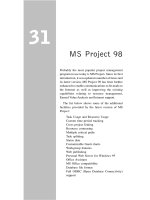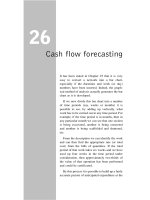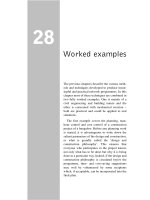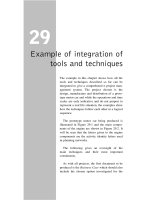Project Planning and Control Part 10
Bạn đang xem bản rút gọn của tài liệu. Xem và tải ngay bản đầy đủ của tài liệu tại đây (132.96 KB, 22 trang )
Glossary
Activity An operation on a network which
takes time (or other resources) and is indicated by
an arrow.
Actual cost of work performed (ACWP) Cu-
mulative actual cost (in money or manhours) of
work booked in a specific period.
Actual hours The manhours actually expended
on an activity or contract over a defined period.
AoN Activity on Node.
AoA Activity on Arrow.
Arithmetical analysis A method for calcu-
lating floats arithmetically.
Arrow A symbol on a network to represent an
activity or dummy.
Arrow diagram A diagram showing the inter-
relationships of activities.
Back end The fabrication, construction and
commissioning stage of a project.
Backward pass A process for subtracting dura-
tions from previous events, working backwards
from the last event.
Banding The subdivision of a network into
horizontal and vertical sections or bands to aid
identification of activities and responsibilities.
Bar chart See Gantt chart.
Beta (b) distribution Standard distribution
giving the expected time te = (a + 4m + b)/6.
Budget Quantified resources to achieve an
objective, task or project by a set time.
Project Planning and Control
Budgeted cost of work performed (BCWP) See Earned Value.
Budgeted cost of work scheduled (BCWS) Quantified cost (in money or
manhours) of work scheduled (planned) in a set time.
Budget hours The hours allocated to an activity or contract at the estimate
or proposal stage.
Business case The document setting out the information and financial plan
to enable decision makers to approve and authorize the project.
Calendar Time scale of programme using dates.
Capital cost The project cost as shown in the balance sheet.
Cash flow Inward and outward movement of money of a contract or
company.
Change control The process of recording, evaluating and authorizing
project changes.
Change management The management of project variations (changes) in
time, cost and scope.
Circle and link method See Precedence diagram.
Close out procedure The actions implemented and documents produced at
the end of a project.
Computer analysis The method for calculating floats, etc. using a
computer.
Configuration management The management of the creation, maintenance
and distribution of documents and standards.
Contingency plan Alternative action plan to be implemented when a
perceived risk materializes.
Cost/benefit analysis Analysis of the relationship between the cost and
anticipated benefit of a task or project.
Cost breakdown structure (CBS) The hierarchical breakdown of costs
when allocated to the work packages of a WBS.
Cost code Identity code given to a work element for cost control
purposes.
Cost control The ability to monitor, compare and adjust expenditures and
costs at regular and sufficiently frequent intervals to keep the costs within
budget.
Cost performance index The ratio of the earned value (useful) cost and the
actual cost.
Cost reporting The act of recording and reporting commitments and costs
on a regular basis.
Cost variance The arithmetical difference between the earned value cost
and the actual cost. This could be positive or negative.
CPA Critical path analysis. The technique for finding the critical path and
hence the minimum project duration.
364
Glossary
CPM Critical path method. See CPA
CPS Critical path scheduling. See CPA.
Critical activity An activity on the critical path which has zero float.
Critical path A chain of critical activities, i.e. the longest path of a project.
Dangle An activity which has a beginning node but is not connected at its
end to a node which is part of the network.
Deliverable The end product of a project or defined stage.
Dependency The restriction on an activity by one or more preceding
activities.
Direct cost The measurable cost directly attributed to the project.
Discounted Cash Flow (DCF) Technique for comparing future cash flows
by discounting by a specific rate.
Distribution schedule A tabular record showing by whom and to whom the
documents of a project are distributed.
Dummy activity A timeless activity used as a logical link or restraint
between real activities in a network.
Duration The time taken by an activity.
Earliest finish The earliest time at which an activity can be finished.
Earliest start The earliest time at which an activity can be started.
Earned value hours See Value hours.
End event The last event of a project.
EVA Earned Value Analysis.
Event The beginning and end node of an activity, forming the intersection
point with other activities.
Feasibility study Analysis of one or more courses of action to establish
their feasibility or viability.
Feedback The flow of information to a planner for updating the network.
Float The period by which a non-critical activity can be delayed.
Free float The time by which an activity can be delayed without affecting
a following activity.
Forward pass A process for adding durations to previous event times
starting at the beginning of a project.
Front end The design and procurement stage of a project. This may or may
not include the manufacturing period of equipment.
Functional organization Management structure of specialist groups carry-
ing out specific functions or services.
Gantt chart A programming technique in which activities are represented
by bars drawn to a time scale and against a time base.
Graphics Computer generated diagrams.
Graphical analysis A method for calculating the critical path and floats
using a linked bar chart technique.
365
Project Planning and Control
Grid Lines drawn on a network sheet to act as coordinates of the nodes.
Hammock An activity covering a number of activities between its starting
and end node.
Hardware The name given to a computer and its accessories.
Histogram A series of vertical columns whose height is proportional to a
particular resource or number of resources in any time period.
Independent float The difference between free float and the slack of a
beginning event.
Indirect cost Cost attributable to a project, but not directly related to an
activity or group within the project.
Input The information and data fed into a computer.
Interface The meeting point of two or more networks or strings.
Interfering float The difference between the total float and the free float.
Also the slack of the end event.
Internal Rate of Return (IRR) The discount rate at which the Net Present
Value is zero.
Investment appraisal Procedure for analysing the viability of an
investment.
Ladder A string of activities which repeat themselves in a number of stages.
Lag The delay period between the end of one activity and the start of
another.
Latest finish The latest time at which an activity can be finished without
affecting subsequent activities.
Latest start The latest time at which an activity can be started without
delaying the project.
Lead The time between the start of one activity and the start of another.
Lester diagram Network diagram which combines the advantages of arrow
and precedence diagrams.
Line of balance Planning technique used for repetitive projects, sub-
projects or operations.
Logic The realistic interrelationship of the activities on a network.
Logic links The link line connecting the activities of a precedence
diagram.
Loop A cycle of activities which returns to its origin.
Manual analysis The method for calculating floats and the critical path
without the use of a computer.
Master network Coordinating network of subnetworks.
Matrix The table of activities, durations and floats used in arithmetical
analysis.
Matrix organization Management structure where functional departments
allocate selected resources to a project.
366
Glossary
Menu Screen listing of software functions.
Method statement Narrative or graphical description of the methods
envisaged to construct or carry out selected operations.
Milestones Key event in a project which takes zero time.
Milestone slip chart Graph showing and predicting the slippage of
milestones over the project period.
Negative float The time by which an activity is late in relation to its
required time for meeting the programme.
Net Present Value (NPV) Aggregate of discounted future cash flows.
Network A diagram showing the logical interrelationships of activities.
Network analysis The method used for calculating the floats and critical
path of a network.
Network logic The interrelationship of activities of a planning network.
Node The intersection point of activities. An event.
Organization breakdown structure (OBS) Diagrammatic representation
of the hierarchical breakdown of management levels for a project.
Organogram Family tree of an organization showing levels of
management.
Output The information and data produced by a computer.
P3 Primavera Project Planner.
Path The unbroken sequence of activities of a network.
PERT Programme Evaluation and Review Technique. Another name for
CPA.
Phase A division of the project life cycle.
Planned cost The estimated (anticipated) cost of a project.
Precedence network A method of network programming in which the
activities are written in the node boxes and connected by lines to show their
interrelationship.
Preceding event The beginning event of an activity.
Printout See Output.
Product Breakdown Structure (PBS) Hierarchical decomposition of a
project into various levels of products.
Program The set of instructions given to a computer.
Programme A group of related projects.
Programme manager Manager of a group of related projects.
Progress report A report which shows the time and cost status of a project,
giving explanations for any deviations from the programme or cost plan.
Project A unique set of co-ordinated and controlled activities to introduce
change within defined time, cost and quality/performance parameters.
Project life cycle All the processes and phases between the conception and
termination of a project.
367
Project Planning and Control
Project management The planning, monitoring and controlling of all
aspects of a project.
Project management plan (PMP) A document which summarizes of all
the main features encapsulating the Why, What, When, How, Where and Who
of a project.
Project manager The individual who has the authority, responsibility and
accountability to achieve the project objectives.
Project organization Organization structure in which the project manager
has full authority and responsibility of the project team.
Project task force See Task force.
Quality management The management of all aspects of quality criteria,
control, documentation and assurance.
Quality plan A plan that sets out the quality standards and criteria of the
various tasks of a project.
Random numbering The numbering method used to identify events (or
nodes) in which the numbers follow no set sequence.
Resource The physical means necessary to carry out an activity.
Resource levelling See Resource smoothing.
Resource smoothing The act of spreading the resources over a project
to use the minimum resources at any one time and yet not delay the
project.
Responsibility code Computer coding for sorting data by department.
Responsibility matrix A tabular presentation showing who or which
department is responsible for set work items or packages.
Return on capital employed Profit (before interest and tax) divided by the
capital employed given as a %.
Retentions Moneys held by employer for period of maintenance (guaran-
tee) period.
Return on Investment (ROI) Average return over a specified period
divided by the investment given as a %.
Risk The combination of the consequences and likelihood of occurrence of
an adverse event or threat.
Risk analysis The systematic procedures used to determine the con-
sequences or assess the likelihood of occurrence of an adverse event or
threat.
Risk identification Process for finding and determining what could pose a
risk.
Risk management Structured application of policies, procedures and
practices for evaluating, monitoring and mitigating risks.
Risk management plan Document setting out strategic requirements for
risk assessment and procedures.
368
Glossary
Risk register Table showing the all identified risks, their owners, degree of
P/I, and mitigation strategy.
Schedule See Programme.
Schedule Performance Index The ratio of earned value cost (or time) and
the planned cost (or time).
Schedule variance The arithmetical difference between the earned value
cost (or time) and the planned cost (or time).
Sequential numbering The numbering method in which the numbers
follow a pattern to assist in identifying the activities.
Slack The period between the earliest and latest times of an event.
Slip chart See milestone slip chart.
SMAC Site man hour and cost. The name of the computer program
developed by Foster Wheeler Power Products Limited for controlling man
hours in the field.
Software The programs used by a computer.
Sponsor The individual or body who has primary responsibility for the
project and is the primary risk taker.
Stakeholder Person or organization who has a vested interest in the project.
This interest can be positive or negative.
Statement of Work (SOW) Description of a work package which defines
the project performance criteria and resources.
Start event The first event of a project or activity.
Subnetwork A small network which shows a part of the activities of a main
network in greater detail.
Succeeding event The end event of an activity.
Task The smallest work unit shown on a network programme (see also
Activity).
Task data The attributes of a task such as duration, start and end date,
resource requirement.
Task force Project organization consisting of a project team which includes
all the disciplines and support services under the direction of a project
manager.
Time estimate The time or duration of an activity.
Toolbar The list of function icons on a computer screen.
Topological numbering A numbering system where the beginning event of
an activity must always have a higher number than the events of any activity
preceding it.
Total float The spare time between the earliest and latest times of an
activity.
Updating The process of changing a network or programme to take into
account progress and logic variations.
369
Project Planning and Control
Value hours The useful work hours spent on an activity. This figure is the
product of the budget hours and the percentage complete of an activity or the
whole contract.
Variance Amount by which a parameter varies from its specified value.
Weightings The percentage of an activity in terms of man hours or cost of
an activity in relation to the contract as a whole, based on the budget
values.
Work breakdown structure (WBS) Hierarchical decomposition of a
project into various levels of management and work packages.
Work package Group of activities within a specified level of a work
breakdown structure.
370









